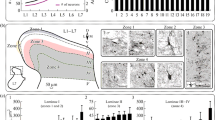Experiments were performed on 80 white male Wistar rats aged 3, 10, 20, 30, 60, 180, and 360 days to address the influences of capsaicin deafferentation on the topography of neurons containing 200-kDal neurofilament protein (NF200+) in the gray matter of the second thoracic segment of the spinal cord. Deafferentation was modeled by s.c. administration of single doses of 150 mg/kg capsaicin to rat pups on day 2 of life. Controls were intact animals (n = 40). NF200+ neurons were detected by labeling cells with anti-NF200 antibodies. The proportion of immunoreactive neurons was calculated by labeling the whole neuron population with NeuroTrace Green Fluorescent Nissl Stain. The results obtained from these experiments show that NF200+ neurons were detected in the ventral horn, the intermediate zone, and the dorsal horn of the spinal cord and were discriminated by their morphometric characteristics. Administration of capsaicin led to identical decreases in the numbers and mean cross sectional areas of medially and laterally located NF200+ motoneurons in the spinal cord (plate IX). In the intermediate zone (plate VII) and dorsal horn (plates III–IV), there were no changes in the numbers of NF200+ neurons, though the mean cross sectional area was greater than that in controls.
Similar content being viewed by others
References
P. M. Maslyukov, V. V. Proseva, V. V. Shilkin, et al., “Age-related changes in TRPV1-immunoreactive afferent neurons on chemical deafferentation with capsaicin,” in: Scientific Studies: Current Questions in Pain: Mechanisms of Occurrence and Means of Correction, Biznesofset, Minsk (2010). Pp, 66–69.
V. V. Proseva, V. V. Shilkin, M. B. Korzina, et al., “Changes in TRPV1-immunoreactive neurons in the sensory ganglia of the spinal nerves in rats in response to capsaicin,” Morfologiya, 139, No. 3, 41–45 (2011).
C. P. Capano, R. Pernas-Alonso, and U. Porzio, “Neurofilament homeostasis and motoneurone degeneration,” Bioessays, 23, 24–33 (2001).
G. Jancsó, A. Juhász, M. Dux, et al., “Axotomy prevents capsaicin-induced sensory ganglion cell degeneration,” Prim. Sens. Neuron, 2, 159–165 (1997).
M. L. Kirfides, M. P. Kurnellas, L. Clark, and B. P. Bryant, “Calcium responses of chicken trigeminal ganglion neurons to methyl anthranilate and capsaicin,” J. Exp. Biol., 207, 715–722 (2004).
Q. P. Ma, “Expression of capsaicin receptor (VR1) by myelinated primary afferent neurons in rats,” Neurosci. Lett., 319, 87–90 (2002).
O. Obreja, A. Klusch, N. Ponelies, et al., “A subpopulation of capsaicin-sensitive porcine dorsal root ganglion neurons is lacking hyperpolarization-activated cyclic nucleotide-gated channels,” Eur. J. Pain, 12, 775–789 (2008).
B. Rexed, “The cytoarchitectonic organization of the spinal cord of the cat,” J. Comp. Neurol., 96, 415–495 (1952).
G. Shaw, C. Yang, R. Ellis, et al., “Hyperphosphorylated neurofilaments NF-H is a serum biomarker of axonal injury,” Biochem. Biophys. Res. Commun., 336, 1268–1277 (2005).
T. J. Steiner and L. M. Turner, “Cytoarchitecture of the rat spinal cord,” J. Physiol., 222, 123–125 (1972).
T. Ueno, Y. Ohori, J. Ito, et al., “Hyperphosphorylated neurofilaments NF-H as a biomarker of the efficacy of minocycline therapy for spinal cord injury,” Spinal Cord, 49, 333–336 (2011).
N. Yoshimira, S. L. Erdman, M. W. Snider, and W. C. de Groat, “Effects of spinal cord injury on neurofilament immunoreactivity and capsaicin sensitivity in rat dorsal root ganglion neurons innervating the urinary bladder,” Neuroscience, 83, No. 2, 633–643 (1998).
Author information
Authors and Affiliations
Corresponding author
Additional information
Translated from Morfologiya, Vol. 144, No. 6, pp. 20–25, November–December, 2013.
Rights and permissions
About this article
Cite this article
Porseva, V.V. Topography and Morphometric Characteristics of NF200+ Neurons in the Gray Matter of the Spinal Cord after Capsaicin Deafferentation. Neurosci Behav Physi 44, 919–923 (2014). https://doi.org/10.1007/s11055-014-0003-6
Received:
Revised:
Published:
Issue Date:
DOI: https://doi.org/10.1007/s11055-014-0003-6



